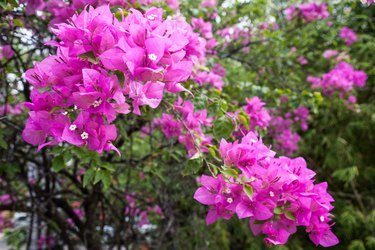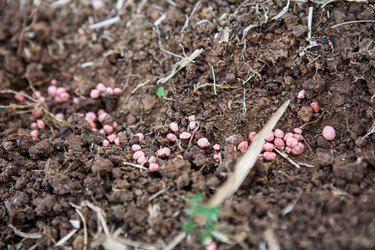
Instead of offering colorful flowers, bougainvillea (Bougainvillea spp.) packs its punch through vibrant, modified leaves known as bracts. The crepe-like bracts cradle bougainvillea's creamy, miniature blooms and give rise to the name paper flower. Hardy from U.S. Department of Agriculture plant hardiness zones 9b through 11, this South American native likes its care simple and lean. It rewards restraint with vivid bracts exploding with bougainvillea color.
Get Light Right
Video of the Day

Colorful bougainvillea depend on plentiful sun. Full sun and high light intensity brings out their finest color. Put bougainvillea in low light or shade and they may drop their bracts. Short day length prompts their heaviest, most colorful flowering. As autumn days grow shorter and nights grow longer, bougainvillea bracts shift. Color fills the modified leaves. The short-day months from fall to early spring provide the most intense bougainvillea color. Artificial night light from security lights or street lamps interferes with the timetable, reducing bougainvillea blooms and colorful bracts.
Video of the Day
Balance Soil and Nutrients

Bougainvillea does well on a slow, steady diet. Nitrogen and phosphorus fuel growth, but too much fertilizer limits blooms. High nitrogen, including nearby turf fertilizers, sends bougainvillea into growth spurts -- minus its blooms. Use a controlled-release, granular fertilizer with all three numbers the same. A 14-14-14, controlled-release fertilizer at the rate of 3 tablespoons per plant feeds bougainvillea for four months. Scratch the granules into the soil, and water the fertilizer well. Bougainvillea colors best when grown in well-drained, acidic soil with a pH near 5.5 to 6.0. At this pH level, the nutrients bougainvillea prefers are most available to the plant.
Prune Hard and Carefully

Left to its own devices, bougainvillea scrambles 40 feet or more, drenching structures in magnificent color. The flowers and their flashy bracts are borne on the new year's wood. After bougainvillea finishes blooming, prune the lateral branches back to two to three buds from the main stem. This encourages vigorous growth and future color. Prune back errant shoots during the year, as needed, but don't prune too much or you may remove developing flowers. Use sharp bypass pruning shears or loppers, and sterilize the blades with household disinfectant to prevent the spread of disease. Always wear heavy gloves, protective clothing and safety goggles when pruning bougainvillea. Watch out for its 1- to 2-inch thorns.
Water Less and Less

In bougainvillea's native habitat, heavy flowering and colorful bracts come on the heels of dry seasons. The plant colors best when soil is kept dry. Water thoroughly when you water, but then allow the soil to dry to at least a finger's depth before you water again. Bougainvillea growers often withhold water to the point of wilting to trigger bract color and heavy flowering. Don't try that at home -- go too dry and bougainvillea drops its leaves and enters dormancy -- but do avoid overwatering your plant. Established bougainvillea offer spectacular color in the midst of drought. Periodic dry spells get balanced with brilliant bracts and blooms.